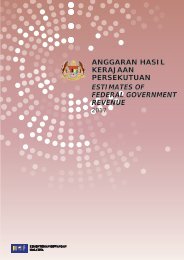WEALTH
2c0esX1
2c0esX1
You also want an ePaper? Increase the reach of your titles
YUMPU automatically turns print PDFs into web optimized ePapers that Google loves.
FOCUS<br />
Outdoor air pollution, which kills an estimated 3<br />
million people every year, has grown by 8% a year<br />
globally. Unless nations take action, the global<br />
death toll is expected to double by 2050 as urban<br />
populations increase and car numbers grow – yet the topic<br />
rarely makes the mainstream media headlines.<br />
Of all the world’s regions, Asia is uniquely exposed.<br />
According to the World Health Organization (WHO),<br />
98% of urban areas in low- and middle-income countries<br />
with populations of more than 100,000 do not meet its air<br />
quality standards. Fast-growing cities in Southeast Asia,<br />
the Western Pacific and the Middle East are the worst<br />
affected, with many showing pollution levels at up to 10<br />
times WHO limits.<br />
Rapid urbanization as well as population and economic<br />
growth across the region is creating pollution from oilfueled<br />
traffic congestion, coal burning for heat and power,<br />
smoke from solid fuel cookers, and a range of pollutants<br />
from inefficient agricultural processes. A changing climate<br />
threatens to make matters worse still.<br />
Hotter towns and cities will generate more<br />
ozone-related pollution from traffic and other<br />
fossil fuel emissions sources. When it’s hotter,<br />
rainfall and wind patterns can also change,<br />
causing particulates to stay suspended in the<br />
air longer.<br />
DEADLY SMOG<br />
Then there’s the vicious circle in which hotter<br />
conditions cause those with access to air<br />
conditioning to use it more, pushing more<br />
pollutants into the air from coal-fired power plants. A<br />
hotter climate could also spark more forest fires,<br />
contributing to region-wide, health-threatening smogs,<br />
such as the 2015 Southeast Asian haze caused by illegal<br />
slash-and-burn practices that affected eight countries.<br />
A hotter climate in Asia will have impact beyond poorer<br />
air quality. As temperatures rise, so do hospital admissions<br />
for respiratory and cardiovascular illnesses. This is an<br />
experience all too familiar lately in Southeast Asia and the<br />
Indian subcontinent, where heatwaves have killed<br />
thousands and put severe pressure on health services.<br />
There are also economic impacts to hotter conditions.<br />
The region’s extensive manufacturing and agriculture<br />
sectors mean its workers face exposure not just to polluted<br />
air but also to the physiological effects of heat.<br />
“There is a lot of evidence to suggest that temperature<br />
extremes impact productivity,” says Joshua Graff Zivin<br />
at the University of California in San Diego’s Global<br />
Health Institute. “There are negative impacts for people<br />
who work in exposed sectors like manufacturing,<br />
» THERE NEEDS TO<br />
BE A TRANSITION<br />
AWAY FROM<br />
BURNING LOW<br />
QUALITY FUELS,<br />
AND MOVING UP<br />
THE ENERGY<br />
LADDER TO<br />
NATURAL GAS «<br />
agriculture and construction. People lose a couple of hours<br />
out of a workweek. Most people don’t realize that the vast<br />
majority of manufacturing is taking place in cheap tin<br />
construction sheds with process heat, lots of activity,<br />
very little cooling and exposure to the outside air from<br />
giant open truck bays.”<br />
MANAGING RISKS<br />
Success in tackling these issues has been hitherto<br />
disappointingly limited and patchy in Asia. It might be<br />
expected, for example, that as the region industrialized<br />
and became wealthier, air pollution would reverse, with<br />
stronger measures put into place to limit the worst effects.<br />
Yet this has been far from the case. Although China has<br />
until recently been the most striking example, where more<br />
than 350 cities do not meet WHO’s air quality standards,<br />
India might now lay claim to the dubious reputation of<br />
being the worst nation for air quality: four Indian cities<br />
occupy the global top 10 for sub-PM2.5 pollution. Other<br />
countries in the region, including Pakistan<br />
and Indonesia, are struggling to tackle the<br />
issue.<br />
There are signs of progress, however. In<br />
April, health, climate and weather experts<br />
from across the region gathered in Colombo,<br />
Sri Lanka, for the first Climate Services Forum<br />
for Health, to help better understand and<br />
manage the risks from heatwaves.<br />
Meanwhile, China has begun to make<br />
significant progress in cleaning up its air, and<br />
more measures are in the pipeline, says Junjie<br />
Zhang, from the University of California in San Diego’s<br />
School of Global Policy and Strategy, who has worked on a<br />
range of climate and air quality related research projects.<br />
“For China, the situation is getting better overall.”<br />
STRONGER ENFORCEMENT<br />
Slower economic growth and a move to a less resourceintensive<br />
economy is part of the reason for improving<br />
trends in China. But policy is also having an impact.<br />
The central government is taking the issue seriously;<br />
it has begun enforcing existing rules more strongly<br />
and will be adding more. Modest air pollution fees are<br />
already in force and new environmental taxes look likely,<br />
says Zhang.<br />
“China’s new minister of environmental protection is<br />
focused on enforcement and this is the key for China, where<br />
there has been poor enforcement at a local level. If a city<br />
does not comply with environmental standards, leaders of<br />
the local government would be called to the ministry and<br />
reprimanded. Local governments are under pressure.<br />
Allianz • 29



